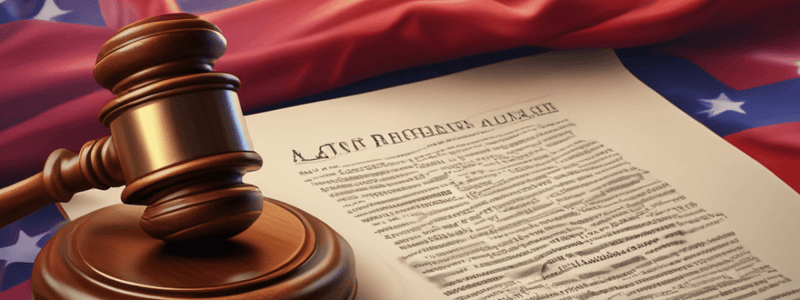Podcast
Questions and Answers
What are the four requirements for a regulation to be considered constitutional according to O'Brien?
What are the four requirements for a regulation to be considered constitutional according to O'Brien?
A. within constitutional power, B. furthers an important governmental interest, C. interest unrelated to free expression suppression, D. restriction no greater than essential
What is the standard that content-based regulations must pass according to strict scrutiny?
What is the standard that content-based regulations must pass according to strict scrutiny?
Narrowly tailored to serve a compelling governmental interest
What is the 'clear and present danger' test used for in cases involving political speech?
What is the 'clear and present danger' test used for in cases involving political speech?
To determine if the speech incites or produces imminent lawless action
What is the presumption held by the Supreme Court regarding prior restraints on speech?
What is the presumption held by the Supreme Court regarding prior restraints on speech?
What are the three criteria that time, place, and manner restrictions on expressive conduct must meet to be constitutional?
What are the three criteria that time, place, and manner restrictions on expressive conduct must meet to be constitutional?
In the case of Clark v. Community for Creative Non-Violence (1984), what regulation was upheld by the Court against a challenge by protesters?
In the case of Clark v. Community for Creative Non-Violence (1984), what regulation was upheld by the Court against a challenge by protesters?
How does the Court determine if symbolic speech, such as burning a flag, is protected under the First Amendment?
How does the Court determine if symbolic speech, such as burning a flag, is protected under the First Amendment?
What is the Spence test used to evaluate in the context of symbolic speech?
What is the Spence test used to evaluate in the context of symbolic speech?
What types of regulations may the government impose on expressive conduct in terms of time, place, and manner restrictions?
What types of regulations may the government impose on expressive conduct in terms of time, place, and manner restrictions?
Under what circumstances can the government still regulate symbolic speech even if it satisfies the Spence test?
Under what circumstances can the government still regulate symbolic speech even if it satisfies the Spence test?
In the context of expressive association, what types of activities does the First Amendment protect the right to engage in?
In the context of expressive association, what types of activities does the First Amendment protect the right to engage in?
What is the primary purpose of time, place, and manner restrictions on expressive conduct?
What is the primary purpose of time, place, and manner restrictions on expressive conduct?
How does the Court determine if time, place, and manner restrictions on expressive conduct are constitutional?
How does the Court determine if time, place, and manner restrictions on expressive conduct are constitutional?
Why is it important for time, place, and manner restrictions on expressive conduct to leave open ample alternative channels for communication?
Why is it important for time, place, and manner restrictions on expressive conduct to leave open ample alternative channels for communication?
Flashcards are hidden until you start studying




